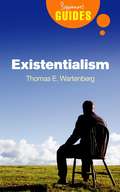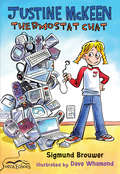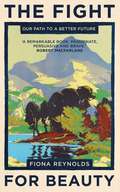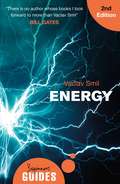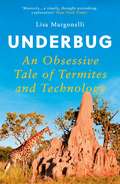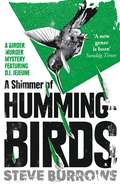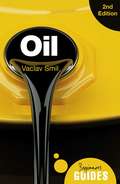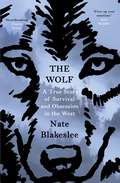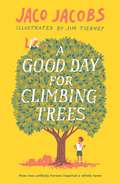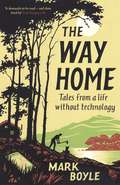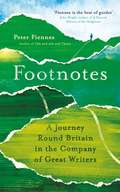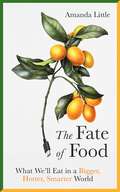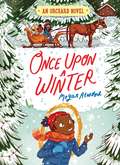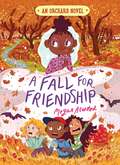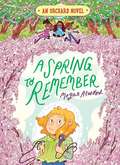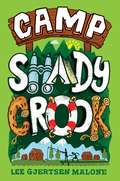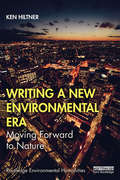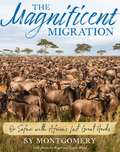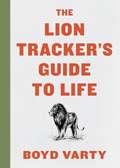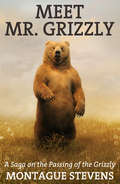- Table View
- List View
Conservation: A Beginner's Guide (Beginner's Guides)
by Paul Jepson Richard LadleThe need to protect nature has never been so pressing. As unprecedented environmental challenges threaten to wipe out many of the planet's species, there is a battle against time to formulate new ways of defending nature. Jepson and Ladle cover all aspects of modern conservation from inspiring successes to the most urgent crises, introduce exciting new techniques such as re-wilding and adaptive management, and explain how we can all contribute. Essential reading for anyone who does not want to see the last of pandas, polar bears, and parrots. Dr. Paul Jepson and Dr. Richard Ladle both work at the University of Oxford.
Justine McKeen, Thermostat Chat (Orca Echoes)
by Sigmund Brouwer Dave WhamondJustine McKeen is on another mission, this time to rid homes and schools of energy vampires. Justine and her friends, with the help of Principal Proctor, are working to reduce the energy consumption of electronics that suck power from the school when they aren't being used. By cutting down on the miscellaneous electrical load of these electronics, the team is also saving money, reducing greenhouse gas emissions and fighting global warming. Too bad they didn't warn Grandpa Blatzo before they started slaying the vampires! Justine McKeen, Thermostat Chat is part of the Justine McKeen series featuring the Queen of Green.
Can Your Outfit Change the World? (PopActivism)
by Erinne PaisleyWhat you choose to wear becomes part of your identity, but it doesn't affect just you. Your clothing sends a message to the world, whether you want it to or not! And often we don't know what that message really is. Can Your Outfit Change the World? looks at how and where clothes are made, how the people who make the clothes are treated and how the companies who sell the clothes affect the health of our planet. Armed with information, you can follow the book's guide to spending your fashion dollars in a responsible and eco-friendly way. Your outfits have more power than you might realize!
The Fight for Beauty: Our Path to a Better Future
by Fiona ReynoldsWe are using the resources of this planet as if we had three to depend on, not one. The threat of climate change looms large, yet our vision for the future remains based on materialism rather than values. While our politicians compete for economic credibility, there is no one with any power or influence who is showing us a different path.Conservationist and campaigner Dame Fiona Reynolds makes the case for the power of beauty and how it can lead us towards solutions to present crises. She demonstrates the irresistible way in which it forces its way into our decisions and debates. A stirring polemic, The Fight for Beauty warns of the dark future ahead but also demonstrates that this isn't inevitable - an alternative future is within our reach, if there is a will and a want to work hard enough to achieve it.
Energy: A Beginner's Guide (Beginner's Guides)
by Vaclav SmilWith one famous equation, E=mc2, Einstein proved all matter can be described as energy. It is everywhere and it is everything. In this newly updated and engaging introduction, renowned scientist Vaclav Smil explores energy in all its facets – from the inner workings of the human body to what we eat, the car we drive and the race for more efficient and eco-friendly fuels. Energy: A Beginner's Guide highlights the importance of energy in both past and present societies, by shedding light on the science behind global warming and efforts to prevent it, and by revealing how our daily decisions affect energy consumption. Whether you're looking for dinner table conversation or to further your own understanding, this book will amaze and inform, uncovering the truths and exposing the myths behind one of the most important concepts in our universe.
Oak and Ash and Thorn: The Ancient Woods and New Forests of Britain
by Peter FiennesA Guardian Best Nature Book of the Year The magic and mystery of the woods are embedded in culture, from ancient folklore to modern literature. They offer us refuge: a place to play, a place to think. They are the generous providers of timber and energy. They let us dream of other ways of living. Yet we now face a future where taking a walk in the woods is consigned to the tales we tell our children. Immersing himself in the beauty of woodland Britain, Peter Fiennes explores our long relationship with the woods and the sad and violent story of how so many have been lost. Just as we need them, our woods need us too. But who, if anyone, is looking out for them?
Underbug: An Obsessive Tale of Termites and Technology
by Lisa MargonelliWho has the answer to the world&’s fuel problems? How can we bring ruined land back to life? Where do roboticists turn when they try to engineer a hive mind? Termites. Strange though it may seem, scientists are looking to these much-reviled insects as little guides to the biggest of ideas. Lisa Margonelli follows them to find out how termites could change the world. A masterpiece of popular science, Underbug touches on everything from metaphysical meditation, technological innovation and the psychology of obsession to good old-fashioned biology.
A Shimmer of Hummingbirds: A Birder Murder Mystery
by Steve BurrowsChief Inspector Domenic Jejeune hopes an overseas birding trip will hold some clues to solving his fugitive brother&’s manslaughter case. Meanwhile, in Jejeune&’s absence his long-time nemesis has been drafted in as cover to investigate an accountant&’s murder. And unfortunately Marvin Laraby proves just a bit too effective in showing how an investigation should be handled. With the manslaughter case poised to claim another victim, Jejeune learns an accident back home in Britain involving his girlfriend, Lindy, is much more than it seems. Lindy is in grave danger, and she needs Jejeune. Soon, he is faced with a further dilemma. He can speak up on a secret he has discovered relating to Laraby&’s case, knowing it will cost his job on the north Norfolk coast he loves. Or he can stay silent, and let a killer escape justice. Turns out that sometimes the wrong choice is the only one there is.
Oil: A Beginner's Guide (Beginner's Guides)
by Vaclav SmilWorld acclaimed scientist Vaclav Smil reveals everything there is to know about nature's most sought-after resourceOil is the lifeblood of the modern world. Without it, there would be no planes, no plastic, no exotic produce, and a global political landscape few would recognise. Humanity&’s dependence upon oil looks set to continue for decades to come, but what is it? Fully updated and packed with fascinating facts to fuel dinner party debate, Professor Vaclav Smil's Oil: A Beginner's Guide explains all matters related to the &‘black stuff&’, from its discovery in the earth right through to the controversy that surrounds it today.
The Wolf: A True Story of Survival and Obsession in the West
by Nate BlakesleeA New Statesman Book of the Year The wolf stands at the forefront of the debate about our impact on the natural world. In one of the most celebrated successes of modern conservation, it has been reintroduced to Yellowstone National Park. What unfolds is a riveting multi-generational saga, at the centre of which is O-Six, a charismatic alpha female beloved by park rangers and amateur spotters alike. As elk numbers decline and the wolf population rises, those committed to restoring an iconic landscape clash with those fighting for a vanishing way of life; hunters stalk the park fringes and O-Six&’s rivals seek to bring an end to her dominance of the stunningly beautiful Lamar Valley.
A Good Day for Climbing Trees
by Jaco Jacobs*Nominated for the 2019 CILIP Carnegie Medal* How two unlikely heroes inspire a whole town by fighting to save a tree Sometimes, in the blink of an eye, you do something that changes your life forever. Like climbing a tree with a girl you don't know. Marnus is tired of feeling invisible, living in the shadow of his two brothers. His older brother is good at breaking swimming records and girls&’ hearts. His younger brother is already a crafty entrepreneur who has tricked him into doing the dishes all summer. But when a girl called Leila turns up on their doorstep one morning with a petition, it&’s the start of an unexpected adventure. And finally, Marnus gets the chance to be noticed...
Boom!: The Violent Supernovas, Galactic Explosions, and Earthly Mayhem that Shook our Universe
by Bob BermanLooking at the night sky, you&’d be forgiven for thinking it&’s all quiet up there in space. But you&’d be wrong. Extreme events are forever unfolding: galaxies explode, cosmic debris hurtles through the heavens and our own Milky Way is on a collision course with the giant Andromeda galaxy. Mayhem moulded the cosmos, shaped life on Earth and at times threatened to end it. With an enduring sense of wonder, through cataclysms great and small, Bob Berman presents a destructive history of our universe.
The Way Home: Tales from a Life Without Technology
by Mark BoyleIt was 11pm when I checked my email for the last time and turned off my phone for what I hoped would be forever. No running water, no car, no electricity or any of the things it powers: the internet, phone, washing machine, radio or light bulb. Just a wooden cabin, on a smallholding, by the edge of a stand of spruce. In this honest and lyrical account of a remarkable life without modern technology, Mark Boyle explores the hard won joys of building a home with his bare hands, learning to make fire, collecting water from the spring, foraging and fishing. What he finds is an elemental life, one governed by the rhythms of the sun and seasons, where life and death dance in a primal landscape of blood, wood, muck, water, and fire – much the same life we have lived for most of our time on earth. Revisiting it brings a deep insight into what it means to be human at a time when the boundaries between man and machine are blurring.
Footnotes: A Journey Round Britain in the Company of Great Writers
by Peter Fiennes&‘The premise of this book is simple, or that is what it seemed when I started.&’ Peter Fiennes follows in the footsteps of twelve inspirational writers, bringing modern Britain into focus by peering through the lens of the past. The journey starts in Dorset, shaped by the childhood visions of Enid Blyton, and ends with Charles Dickens on the train that took him to his final resting place in Westminster Abbey. From the wilds of Skye and Snowdon, to a big night out in Birmingham with J. B. Priestley and Beryl Bainbridge, Footnotes is a series of evocative biographies, a lyrical foray into the past, and a quest to understand Britain through the books, journals and diaries of some of our greatest writers. And as Fiennes travels the country, and roams across the centuries, he wonders: &‘Who are we? What do we want? They seemed like good questions to ask, in the company of some of our greatest writers, given these restless times.&’
The Fate of Food: What We’ll Eat in a Bigger, Hotter, Smarter World
by Amanda LittleIs the future of food looking bleak – or better than ever? At a time when every day brings news of drought and famine, Amanda Little investigates what it will take to feed a hotter, hungrier, more crowded world. She explores the past along with the present and discovers startling innovations: remote-control crops, vertical farms, robot weedkillers, lab-grown meat, 3D-printed meals, water networks run by supercomputers, cloud seeding and sensors that monitor the microclimate of individual plants. She meets the creative and controversial minds changing the face of modern food production, and tackles fears over genetic modification with hard facts. The Fate of Food is a fascinating look at the threats and opportunities that lie ahead as we struggle for food security. Faced with a perilous future, it gives us reason to hope.
Castillos de arena (¡Arriba la Lectura! Level D #76)
by Lindsay Edwards Elsie NelleyNIMAC-sourced textbook <p><p> ¡Es divertido hacer castillos en la playa! ¿Qué pasa con los castillos de arena cuando vienen las olas?
Once Upon a Winter (An Orchard Novel #2)
by Natalie Andrewson Megan AtwoodWintertime at the orchard has Peter learning some important lessons about speaking up in this second novel of a sweet series about the bonds of friendship.Blanketed in snow, the orchard looks like a magical wonderland. But Peter is not so charmed by his new life. He just can’t ignore how he’s always ignored any longer. Sarah, Lizzie, and Olive are always talking over him and bossing him around. And on top of that, it’s really cold outside. One January day, Peter reluctantly agrees to join the girls on a carriage ride through the freshly fallen snow. But things go terribly wrong when a dog incident has the horses running away in fear, with Peter and the carriage trailing dangerously behind them. Then, Peter hits his head on a passing branch and is thrown to the ground. Woozy, Peter wakes up alone in the snow but he makes his way to a cozy cottage. Kai, the cool new kid, opens the door and welcomes Peter inside. Kai shows him a magical mirror that brings the two new friends to another world. A world where people listen to Peter and need his help to defeat dragons, warlocks, and other scary things. Then Peter wakes up in the hospital with a bandage around his head. Everyone is so happy to see him awake. Peter tries to tell them all about the mirror but they dismiss his experience as a wild dream. When Peter goes back to school, it seems like Kai knows what Peter’s talking about. Could the dream have been real? Is there really a magic portal deep in the woods behind the orchard? Even if everyone thinks he’s crazy, Peter is determined to find out.
A Fall for Friendship (An Orchard Novel #3)
by Natalie Andrewson Megan AtwoodOlive doesn’t believe in ghosts, but something weird is definitely going on at the orchard and she wants to get to the bottom of it in this third novel of a sweet series about the bonds of friendship.Olive, Peter, Sarah, and Lizzie are getting ready for Halloween. This year, they’re planning a zombie hayride and a haunted barn party. As they set up, Lizzie’s older sister, Gloria tells them that a ghost haunts the very barn they’re decorating. According to Gloria, the ghost is angry and desperate for revenge. Lizzie, Sarah, and Peter are fascinated, but Olive doesn’t believe any of it. Not even when strange, ghostly things keep happening all around them. Olive sets out to prove that ghosts don’t exist and that Gloria and her friends are behind it all. But the more Olive investigates, the scarier things become. Could Gloria be telling the truth? Is the orchard really haunted?
A Spring to Remember (An Orchard Novel #4)
by Natalie Andrewson Megan AtwoodSpring has sprung and the orchard crew tries their hand at matchmaking in this final novel of a sweet series about the bonds of friendship.The orchard is putting on a Valentine’s Day dance! And the town is once again totally involved. Lizzie and her friends have been tasked with decorations. When all four of them go into town to buy them, they see Sheriff Hadley and Sarah’s mom kissing beside a building! Sarah is shocked. But she’s the only one. Lizzie tries to comfort her but then to her surprise, Sarah is thrilled! She’s so thrilled in fact, she wants to hurry them along. She wants a proposal. And she wants the gang’s help to get it. Lizzie is unsure—she thinks people should be able to do what they want. But Sarah is her best friend, so… Meanwhile, Lizzie has been taking singing lessons. She hates them—she’s really not that good. But her parents decided she needed to “find her voice” and thought this was a great way to do it. Lizzie doesn’t want to hurt their feelings so she doesn’t say anything. Sarah gets the gang to scheme ways to hint to Sheriff Hadley and her mom that they all know they’re together and they want them to get married. Now Lizzie’s really uncomfortable. Why doesn’t Sarah just talk to her mom? To make matters worse, her friends come up with an idea of a romantic moment at the Valentine’s Day Dance that involves a proposal and…a singing Lizzie. Can Lizzie find the courage to put a stop to all this? Or is she going to face her worst nightmare?
Ruse
by Cindy PonIn near-future Shanghai, a group of teens have their world turned upside down when one of their own is kidnapped in this action-packed follow-up to the “positively chilling” (The New York Times) sci-fi thriller Want.Jason Zhou, his friends, and Daiyu are still recovering from the aftermath of bombing Jin Corp headquarters. But Jin, the ruthless billionaire and Daiyu’s father, is out for blood. When Lingyi goes to Shanghai to help Jany Tsai, a childhood acquaintance in trouble, she doesn’t expect Jin to be involved. And when Jin has Jany murdered and steals the tech she had refused to sell him, Lingyi is the only one who has access to the encrypted info, putting her own life in jeopardy. Zhou doesn’t hesitate to fly to China to help Iris find Lingyi, even though he’s been estranged from his friends for months. But when Iris tells him he can’t tell Daiyu or trust her, he balks. The reunited group play a treacherous cat and mouse game in the labyrinthine streets of Shanghai, determined on taking back what Jin had stolen. When Daiyu appears in Shanghai, Zhou is uncertain if it’s to confront him or in support of her father. Jin has proudly announced Daiyu will be by his side for the opening ceremony of Jin Tower, his first “vertical city.” And as hard as Zhou and his friends fight, Jin always gains the upper hand. Is this a game they can survive, much less win?
Camp Shady Crook
by Lee Gjertsen MaloneIt’s Ocean’s Eleven set in a summer camp as two kids try to one-up each other in a con competition at a camp that isn’t quite what it seems… <P><P>For Archie, the start of summer means another stint at Camp Shady Brook, where there is a lot more to the camp than meets the eye—just like Archie and his now blended family. But thanks to a con Archie developed last year, he’s finally somebody…and he’s not going to lose that status to the new girl, Vivian. <P><P> For Vivian, thanks to an incident That Shall Not Be Named or Spoken Of, her summer of exotic travels with Mom and Dad has turned into traveling to a dump of a summer camp in the middle of nowhere. But thanks to perfect timing, Vivian soon finds herself in a ring of kids trying to out-con each other—and discovers Camp Shady Brook is more like Camp Shady Crook. And when one final, massive con could cost Vivian the first friends she’s had in a while, can she and Archie figure out a way to make things right?
Writing a New Environmental Era: Moving forward to nature (Routledge Environmental Humanities)
by Ken HiltnerWriting a New Environmental Era first considers and then rejects back-to-nature thinking and its proponents like Henry David Thoreau, arguing that human beings have never lived at peace with nature. Consequently, we need to stop thinking about going back to what never was and instead work at moving forward to forge a more harmonious relationship with nature in the future. Using the rise of the automobile and climate change denial literature to explore how our current environmental era was written into existence, Ken Hiltner argues that the humanities—and not, as might be expected, the sciences—need to lead us there. In one sense, climate change is caused by a rise in atmospheric CO2 and other so-called greenhouse gases. Science can address this cause. However, approached in another way altogether, climate change is caused by a range of troubling human activities that require the release of these gases, such as our obsessions with cars, lavish houses, air travel and endless consumer goods. The natural sciences may be able to tell us how these activities are changing our climate, but not why we are engaging in them. That’s a job for the humanities and social sciences. As this book argues, we need to see anthropogenic (i.e. human-caused) climate change for what it is and address it as such: a human problem brought about by human actions. A passionate and personal exploration of why the Environmental Humanities matter and why we should be looking forward, not back to nature, this book will be essential reading for all those interested in the future and sustainability of our planet.
The Magnificent Migration: On Safari with Africa's Last Great Herds
by Sy MontgomerySibert medalist and National Book Award finalist Sy Montgomery takes readers on a staggering, emotional journey alongside the greatest land migration on the planet earth—that of the wildebeest across the Serengeti—to explore the mystery and wonder of migration in a sweeping story sure to leave its mark. With full color photography. Sibert medalist Sy Montgomery takes readers on a staggering, emotional journey alongside the greatest land migration on earth—that of the wildebeest across the Serengeti—to provide a you-are-there account of one of nature’s most fascinating occurrences. Montgomery explores the wonder of migration, asking questions like, how do migration patterns sculpt the environment? Why do animals migrate? And how do they know where to go? With lyrical prose, abundant facts, and the inclusion of other species who undertake remarkable migrations, Montgomery makes a journey of thousands of miles fly by—but not without leaving its mark. Full color photography.
The Lion Tracker's Guide to Life
by Boyd VartySomewhere deep inside, you know what your gift, purpose, and mission are. Boyd Varty, a lion tracker and life coach, reveals how the wisdom from the ancient art of tracking can teach you how to recognize these essential ingredients in a meaningful life. Know how to navigate, don’t worry about the destination, and stay alert. These are just a few of the strategies that contribute to both successful lion tracking and a life of fulfillment. When we join Boyd Varty and his two friends tracking lions, we are immersed in the South African bush, and, although we learn some of the skills required for actual tracking, the takeaways are the strategies that can be applied to our everyday lives. Trackers learn how to use all of their senses to read the environment and enter into a state of “greater aliveness.” When we learn to find and follow our inner tracks, we learn to see what is deeply important to us. In the same way the trip in the classic Zen and the Art of Motorcycle Maintenance was a vehicle to examine how to live out our values, the story of this one-day adventure—with danger and suspense along the way—uses the ancient art of tracking to convey profound lessons on how to live a purposeful, meaningful life of greater harmony.
Meet Mr. Grizzly: A Saga on the Passing of the Grizzly
by Montague StevensMeet Mr. Grizzly, first published in 1943, is the memoir of Montague Stevens – a Cambridge-educated Englishman who was a cattle-rancher in New Mexico, and who had a passion for hunting grizzly bears (with the help of his hunting dogs). The book chronicles some of his many adventures of hunting, dog- and horse-training, and on the natural history of the region. Included are 15 pages of illustrations.
